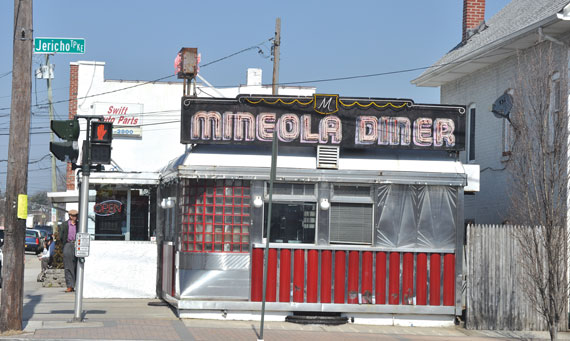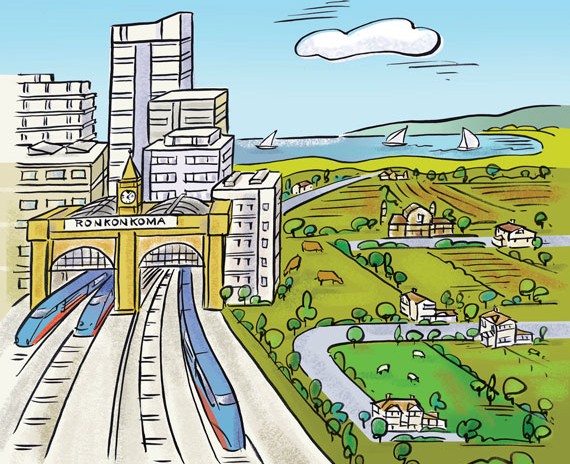These days Long Island is enjoying a boom in real estate development along the bustling train lines that serve as major arteries to New York City. But the region is methodically managing that exponential growth with a measured, if not restrictive, approach toward anything that resembles even modestly tall buildings in Queens — let alone Manhattan.
Villages and hamlets, where virtually all the development decisions are made on hyper-local Long Island, remain on guard for a growth spurt that threatens the decades-old suburban character of Nassau and Suffolk counties, industry sources told The Real Deal.
“There is always the resistance to becoming the next Queens,” said David Pennetta, executive director and managing broker at Cushman & Wakefield’s Long Island office, who also sits on the planning board of Huntington. “They don’t want the building height. They don’t want the density.”
Sean McLean, vice president of planning and development at the Plainview-based real estate firm Renaissance Downtowns, said builders must tread lightly when proposing projects that exceed three stories.
“If you just go to them and say you want to build 300 multifamily units five stories tall, most communities would try to run you out of town,” he said, adding that those kinds of projects must be part of more comprehensive plans that include benefits to the local community. “You might finally get it through, but only after 10 years of going through hell and back,” he said.
The resistance to height and density in Long Island is deep-seated and based on the Island’s historical role as the birthplace of suburbia.
“‘Urban’ is a bad word. It’s in the psyche of the residents of the suburbs, who say, ‘Don’t urbanize. Don’t Queensify us,’” McLean said.
Those concerns have intensified in Long Island over the years since many of the region’s decisions still get done at the grassroots level. While New York City is governed by a single zoning resolution, Long Island has 175 different zoning and building districts, including 126 in Nassau County alone, according to Pennetta of C&W.
That means each development project must get the blessing of local zoning officials, sometimes in the face of opposition from civic organizations.
“Here, it’s much more localized,” the commercial broker said about those governing bodies. “If you piss off your constituents in one area, those are the same people voting for you. In Manhattan, if you’re doing something in Queens that is pissing people off, you still have nine million other people that might still vote for you.”
Some people involved in Long Island’s real estate market believe discrimination may play a significant role in the opposition to height. “There’s a huge portion of racism mixed into this,” one person, who asked to remain anonymous, said. “To them, density means Democrats and brown people moving to your community.”
Another source put it this way: “They picture housing projects in Queens compared to a single-family house with a white picket fence around it.”

RXR Plaza in Uniondale
Of course, there are several legitimate reasons why Long Island residents are reluctant to green-light sprawling residential (and commercial) complexes. Such dense developments can impose stress on the region’s already-strained infrastructure, creating traffic, congestion and even sewage issues.
Tall buildings east of Queens would also stand out and could potentially become eyesores in the otherwise low-profile region, according to several people in the industry. Most towns restrict height to “maintain a balanced visual ascetic with development below tree lines of 70 feet or so,” said Chris Stack, a commercial broker and first vice president at CBRE.
The tallest building on Long Island is Nassau University Medical Center at 19 stories, according to data from Emporis. The medical center serves as a public teaching hospital affiliated with Stony Brook University. Long Island’s second-tallest property is RXR Plaza in Uniondale, which consists of two 15-story reflective glass towers. The trophy office complex serves as the corporate headquarters of RXR Realty, one of the largest commercial real estate owners in New York City.
“We don’t say, ‘Let’s just build tall everywhere.’ You don’t want to drop in one building that is out of place and towers over everything else,” Eric Alexander, director of the nonprofit planning group Vision Long Island, told TRD. “It’s all done with a lot of planning and great care.”
Even if local villages sought tall buildings, they might not be feasible for financial reasons. Building above five stories often requires developers to abandon wood frames in favor of steel, significantly increasing the cost of construction.
“There is a diminished return where you need to have enough density and enough height in order for it to make sense financially,” said Daniel Deegan, an attorney at the Uniondale-based law firm Forchelli, Curto, Deegan, Schwartz, Mineo & Terrana, who specializes in zoning issues on Long Island.
Recent expansion in Nassau and Suffolk has centered on downtown areas where the Long Island Rail Road stops. In the last nine years alone, 11,000 units of transit-oriented housing development have been approved in those regions, according to Alexander. Many of these projects are mixed-use developments that include office or retail on the first few floors and residential units above that.
“There is more transit-oriented development going on than I’ve seen in my lifetime,” Alexander said.
There is also evidence that at least some of Long Island’s more active real estate markets are slowly opening up to the idea of accepting increased density and height. The Village of Hempstead has emerged as one of the area’s most open-minded communities for new developments, sources said.
Renaissance Downtowns, for instance, plans to break ground late this spring on a five-story multifamily building with 336 units in Hempstead. The developer has been approved to build up to 10 stories with a density of 170 units per acre there.
“The Village of Hempstead is very receptive,” said McLean.
Mineola is also growing rapidly and with increased height. The village has three $80 million projects in the works, including two that are seven or more stories high, Alexander of Vision Long Island said. One of them is a Lalezarian Properties development at One Third Avenue, which calls for replacing a demolished KeySpan building with a 312-unit multifamily property set to be 11 stories tall.

The Mineola Diner (Built in 1948)
Lalezarian had to apply for a zoning variance for the One Third Avenue site. However, that process was streamlined by Mineola’s master plan, which empowers the village board to bypass the local planning and zoning boards. A representative for Lalezarian declined to comment.
“Mineola has been a poster child for transit-oriented development density and height,” said Deegan.
“People judge communities by their downtowns,” he added. “Mineola is recognizing its railroad station and downtown as assets that can be infused with vibrancy and economic activity. It will make it a better place to live in and increase the property values of single-family homes.”
There are several other fast-growing development areas that industry insiders point to as being more receptive to building relatively high, including the Islip hamlet of Ronkonkoma, the Village of Great Neck Plaza, Farmingdale, Long Beach, Glen Cove and Riverhead.
Even a blighted section of the ritzy Hamptons is opening up to increased density. Riverside, a hamlet of Southampton and one of the poorest parts of Long Island, has sought to rejuvenate itself by revamping its zoning code and opening up to development. The median family income in Riverside was $53,250 in 2014, up from $37,833 in 2010, according to U.S. Census Bureau data.
In December 2015, Renaissance received zoning approval for a 3.2-million-square-foot multifamily project there with nearly 2,300 units. The development calls for height of up to four-and-a-half stories, roughly double what’s normally allowed, and about 50 times the permitted density.
McLean said local residents were very receptive to the development because it includes community benefit funds aimed at cleaning up the crime-riddled area. He added that not only does Riverside struggle with open-air drug and prostitution markets, but it also has a significant human-trafficking problem.
The Riverside plan calls for money to be directed toward social goodwill and anti-recidivism programs, as well as substantial environmental initiatives to repair the wetlands in the area, according to the Long Island developer.
“Two hundred people came to the vote for the zoning and stood up in roaring applause to the unanimous approval,” McLean said. “It was incredible.”
Farmingdale serves as another example of an underinvested area undergoing a recent revitalization, highlighted by a flurry of downtown apartment developments rising near the village’s train station.
“For years a good portion of the stores downtown were empty,” said Deegan. “Now you go there on a Friday night and it’s a vibrant downtown with restaurants and bars and people walking the streets. A lot of areas that are ripe for this type of development are areas that are blighted and are usually considered the bad part of town or the other side of the tracks.”
Of course, parts of Long Island are naturally less likely to welcome developers who want to build tall. That includes Southold, Smithtown, Shelter Island and Huntington, Alexander noted. And, last but not least, Fire Island, which does not permit people to drive cars during the summer.
But despite its inherent opposition to height and density, Long Island is in desperate need of more multifamily rental options, according to several sources. The region, which has more than 2.8 million residents (not counting another 5 million who live in Brooklyn and Queens), is facing a “rental housing crisis,” a study by the Regional Plan Association for the Long Island Community Foundation concluded in 2013.
The report found that 64 percent of Long Island renters cannot afford an average two-bedroom rental apartment and that 55 percent of 20- to 34-year-old residents live with their parents or other older relatives — up from 44 percent in 2000.

Rendering of One Third Avenue
“On Long Island, there’s just not a lot of apartment stock. It’s difficult for young people graduating college to figure out where to live,” said Russel Helbling, vice president of the Manhattan-based real estate services firm Sabre Real Estate Group, which has secured space for retail tenants in several downtown transit developments in Nassau and Suffolk. “Eventually you leave,” he noted.
The fear is that a lack of rental options will cause more young people to flee Long Island for other metro areas and that employers will follow them out the door, crippling the broader economy. “The shortage of affordable rental homes is already straining Long Island’s economy and it will make it much harder to compete for jobs in the years ahead,” the Regional Plan Association’s report stated. The nonprofit group called on local, state and federal politicians to take action to create new homes that meet community needs.
McLean said more forward-thinking communities recognize that something needs to be done to prevent too many millennials from abandoning Long Island. “People are recognizing we are going to lose our workforce and our employers. It’s a downward spiral,” he said.
Besides the economic benefits, enhanced rental options can also keep older residents from leaving for one of Florida’s senior communities. Those residents may want to downsize their homes in favor of easier-to-maintain apartments in walkable downtown areas, McLean noted.
“Grandparents are finally realizing they want the same thing,” he said. “It’s come full circle and it’s changing the psyche of the suburbs.”
It remains up in the air whether more Long Island towns will follow in the trend of accepting higher and denser downtowns. For now, all are waiting to see how successful transit-oriented developments in areas such as Mineola, Ronkonkoma and Farmingdale turn out to be.
“Farmingdale got a huge boost to its reputation and Mineola is undergoing the same thing right now,” Deegan said. “I’m hoping people are going to start to say this is an answer to our problems, as opposed to the cause of them.”
